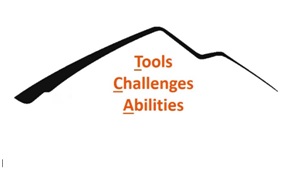
A Coaching Power Tool Created by Stephen Miller
(Leadership Coach, GERMANY)
Many years ago I ran across the Greek word arete (ἀρετή). It struck a chord with me, so I made a note of it for future use. When it came time for me to further develop my coaching and training business, I knew that word had to be part of practice. Though a bit difficult to translate exactly into English, arete in its basic sense means personal excellence – precisely what we strive to reveal to and activate in our clients in our coaching relationship.
Interestingly, there is also the French word arête, which is a type of mountain peak. Combining these two meanings provides the intention of the ACT2 coaching system, comprised of the ACT Coaching Model and the ACT Power Tool – coaching clients to elevate their personal excellence.
You may also notice that ACT is highlighted in the business name I have chosen to operate under, AreteConnecT. That ties into my belief that excellence is uncovered and demonstrated through action. Action in the broad sense –accomplishing something tangible, deliberate observation and reflection, mentally and emotionally recharging, as examples. We make a difference to ourselves and those around us when we are in action. The ACT Coaching Model is designed to guide clients to leading a rich, fulfilling life springing from their true excellent selves, while the ACT Power Tool can be used to discover the deeper value their actions bring.
The ACT Power Tool complements the Coaching Model when applied primarily during the Connect stage as the client is defining actions to be taken. Any action that moves the client forward is beneficial. One-off actions serve to get things done, check items off the to-do list or meet very specific needs. Recurring actions, because of their on-going nature, tend to lead to further growth, deeper learning and greater satisfaction. These are the types of actions that elevate a client’s excellence to a higher level and are the focus of this Power Tool.
The ACT Power Tool is designed to invite the client to identify the internal and external resources they will call upon to achieve their goals and to explore the bigger outcomes of their actions. The stated goal might be to close an important deal, build a high-performing team, be healthier, or enjoy life more. Of course, these goals would need to be more specific to be actionable, but this level of detail is sufficient for purposes of explanation. So often we are focused solely the immediate results of our actions – using the Power Tool will help the client realize just how much more they will gain as they embark on their action plan, providing extra motivation and inspiration to follow through on it.
Once a client has identified a desired action, the Power Tool will identify what the client needs to bring into play, what might happen along the way, and what additional outcomes could be realized. The questions around designing action can be used to set the foundation for the client; the questions related to exploring outcomes can be used to help the client unearth the bigger payoff they will receive.
The three components, Abilities, Challenges, and Tools do not need to be explored in any particular order – go where the energy and your intuition is leading you. Ask some of the example questions, be curious, ask more questions! And the question “What else?” is always powerful to invite the client to dig even deeper!
 |
|
| Sample Questions for Designing Action | Sample Questions for Exploring Outcomes |
| Abilities – focus on what the client already has within them | |
| 1. Which of your strengths are you going to leverage?
2. What skills and experience will support you? 3. How have you successfully applied these strengths in the past? |
1. How will you acknowledge yourself while you’re in action?
2. What will it feel like to bring your strengths into play? 3. What additional mastery will you achieve? |
| Challenges – focus on the growth that comes as a result of overcoming obstacles | |
| 1. What might get in the way of you taking action?
2. What thoughts and feelings come up as you consider this action? 3. How have you addressed similar challenges in the past? |
1. Who are these challenges asking you to be?
2. Who will you become as a result of facing these challenges? 3. What can you do to bring some fun into the challenge? |
| Tools – focus on the support system, including other people, that will enable success | |
| 1. How will your current environment support you?
2. What additional support will you need? 3. How will you go about getting it? |
1. What kind of environmental upgrades will happen?
2. What will be different about you as you create this supportive environment? 3. What more will this environment allow you to do? |